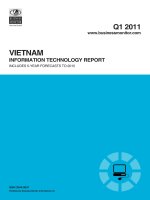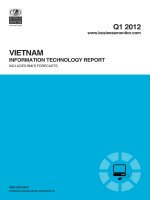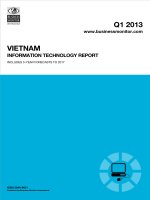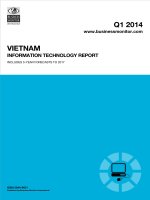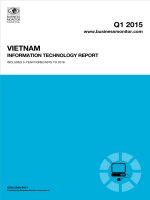Edge AI Technology Report 2023
Bạn đang xem bản rút gọn của tài liệu. Xem và tải ngay bản đầy đủ của tài liệu tại đây (3.07 MB, 117 trang )
2023
EDGE AI
TECHNOLOGY
REPORT
The Guide to Understanding the State
of the Art in Hardware & Software
in Edge AI.
Introduction
4
Chapter I: Overview of Industries and Application Use Cases
8
Industrial & Manufacturing
9
Healthcare
11
Consumer Products
12
Transportation
13
Smart Cities
14
Smart Home
16
Chapter II: Advantages of Edge AI
18
From Cloud to Edge AI
18
Edge AI Advantages
19
Cloud/Edge Computing Continuum: A Powerful Combination
21
Chapter III: Edge AI Platforms
24
TensorFlow Lite
25
PyTorch Mobile
25
OpenVINO
26
NVIDIA Jetson
26
Edge Impulse
26
Caffe2
27
MXNet
28
Chapter IV: Hardware & Software Selection
30
Hardware Considerations
32
Software Considerations
35
Integration Considerations
36
Security Considerations
37
Chapter V: TinyML
38
Introducing TinyML
38
TinyML Advantages and Challenges
39
Tools and Techniques for TinyML Development
39
TinyML in Action: How GreenWaves Enable Next-Generation Products
41
The New Kid on the Block
42
Chapter VI: Edge AI Algorithms
44
Classification Algorithms
45
Support Vector Machines
46
Random Forest
46
Convolutional Neural Networks
46
Detection Algorithms
46
Object-Detection Algorithms
46
Anomaly-Detection Algorithms
48
Event-Detection Algorithms
49
Face-Recognition Algorithms
50
Segmentation Algorithms
51
Tracking AI Algorithms
52
Temporal Event-based Neural Nets (TENNs)
53
Vision Transformers
53
Harmonizing Algorithms with Hardware
53
Chapter VII: Sensing Modalities
54
Vision-Based Sensing Modalities
54
Audio-Based Sensing Modalities
56
Environmental Sensing Modalities
Data Collection Simplified: How Sparkfun Enables Data Logging
Other Sensing Modalities
Chapter VIII: Case Studies
57
58
60
62
Interview with ST: A Glimpse into Edge AI From ST’s Perspective
63
Sensory Inc. - Revolutionizing User Experience with Voice- Activated AI Technologies
65
Pachama - Predicting carbon capture in forests
66
Activ Surgical - Real-time surgical visualizations
67
Medtronic - AI-Powered Endoscopy, Glucose Monitoring, and Cardiology
68
Fero Labs - Reducing Carbon Emissions with IoT
68
NoTraffic - Traffic Management for Smart Cities
69
BloomX - Pollination with Robot Biomimicry
70
Starkey - Advanced Performance for Hearing Aids
71
Motional - Autonomous Robotaxis
72
Chapter IX: Challenges of Edge AI
74
Data Management Challenges
74
Integration Challenges
76
Security Challenges
77
Latency Challenges
78
Scalability Challenges
78
Cost Challenges
80
Power Consumption Challenges
80
Potential Solutions
81
Chapter X: The Future of Edge AI
84
Emergence and Rise of 5G/6G Networks
85
Neuromorphic Computing: Increase AI Intelligence by Mimicking the Human Brain
86
Event-based Processing & Learning: BrainChip’s Neuromorphic AI Solution
87
Data-Efficient AI: Maximizing Value in the Absence of Adequate Quality Data
88
In-Memory Computing for Edge AI
89
Digital In-Memory Computing: An Axelera AI Solution
90
Distributed Learning Paradigms
92
Heterogeneity and Scale-up Challenges
93
Key Stakeholders and Their Roles
93
Conclusion
94
Acknowledgments
96
About the report sponsors
98
About the report partner
110
About the writers
112
About the designers
114
About Wevolver
116
Introduction
The advent of Artificial Intelligence
(AI) over recent years has truly revolutionized our industries and personal
lives, offering unprecedented opportunities and capabilities. However, while
cloud-based processing and cloud AI
took off in the past decade, we have
come to experience issues such as
latency, bandwidth constraints, and
security and privacy concerns, to name
a few. That is where the emergence of
Edge AI became extremely valuable
and transformed the AI landscape.
Edge AI represents a paradigm shift in
AI deployment, bringing computational power closer to the data source. It
allows for on-device data processing
and enables real-time, context-aware
decision-making. Instead of relying
on cloud-based processing, Edge AI
utilizes edge devices such as sensors,
cameras, smartphones, and other
compact devices to perform AI computations on the device itself. Such an
approach offers multitudes of advantages, including reduced latency, improved bandwidth efficiency, enhanced
data privacy, and increased reliability
in scenarios with limited or intermittent connectivity.
4
“Even with ubiquitous 5G, connectivity
to the cloud isn’t guaranteed, and
bandwidth isn’t assured in every case.
The move to AIoT increasingly needs
that intelligence and computational
power at the edge.”
Nandan Nayampally, CMO, Brainchip
While Cloud AI predominantly performs data processing and analysis
in remote servers, Edge AI focuses on
enabling AI capabilities directly on the
devices. The key distinction here lies in
the processing location and the nature
of the data being processed. Cloud AI
is suitable for processing-intensive
applications that can tolerate latency,
while Edge AI excels in time-sensitive
scenarios where real-time processing
is essential. By deploying AI models
directly on edge devices, Edge AI
minimizes the reliance on cloud
connectivity, enabling localized
decision-making and response.
The Edge encompasses the entire
spectrum from data centers to IoT
endpoints. This includes the data
center edge, network edge,embedded edge, and on-prem edge, each
with its own use cases. The compute
requirements essentially determine
where a particular application falls on
the spectrum, ranging from data-center edge solutions to small sensors
embedded in devices like automobile
tires. Vibration-related applications
would be positioned towards one end
of the spectrum, often implemented on
microcontrollers, while more complex
video analysis tasks might be closer
to the other end, sometimes on more
powerful microprocessors.
“Applications are gradually moving towards the
edge as these edge platforms enhance their
compute power.”
Ian Bratt, Fellow and Senior Director of Technology, Arm
5
When it comes to Edge AI, the focus
is primarily on sensing systems. This
includes camera-based systems, audio
sensors, and applications like traffic
monitoring in smart cities. Edge AI
essentially functions as an extensive
sensory system, continuously monitoring
and interpreting events in the world.
In an integrated-technology approach,
the collected information can then be
sent to the cloud for further processing.
Edge AI shines in applications where
rapid decision-making and immediate
response to time-sensitive data are
required. For instance, in autonomous
driving, Edge AI empowers vehicles to
process sensor data onboard and make
split-second decisions to ensure safe
navigation. Similarly, in healthcare,
Edge AI enables real-time patient monitoring, detecting anomalies, and
facilitating immediate interventions.
The ability to process and analyze
data locally empowers healthcare
professionals to deliver timely and
life-saving interventions.
Edge AI application areas can be distinguished based on specific requirements such as power sensitivity, size
limitations, weight constraints, and
heat dissipation. Power sensitivity is a
crucial consideration, as edge devices
are often low-power devices used in
smartphones, wearables, or Internet
of Things (IoT) systems. AI models
deployed on these devices must be
optimized for efficient power consumption to preserve battery life and
prolong operational duration.
Size limitations and weight constraints also play quite a significant role
in distinguishing Edge AI application
areas. Edge devices are typically compact
and portable, making it essential
for AI models to be lightweight and
space-efficient. This consideration is
particularly relevant upon integrating
edge devices into drones, robotics,
or wearable devices, where size and
weight directly impact performance
and usability.
Nevertheless, edge computing
presents significant advantages that
weren’t achievable beforehand.
Owning the data, for instance, provides
a high level of security, as there is no
need for the data to be sent to the
cloud, thus mitigating the increasing
cybersecurity risks. Edge computing
also reduces latency and power
usage due to less communication
back and forth with the cloud, which is
particularly important for constrained
devices running on low power. And
the advantages don’t stop there, as we
are seeing more and more interesting
developments in real-time performance and decision-making, improved
privacy control, and on-device learning,
enabling intelligent devices to operate
autonomously and adaptively without
relying on constant cloud interaction.
“The recent surge in AI has been fueled by a
harmonious interplay between cutting-edge
algorithms and advanced hardware. As we move
forward, the symbiosis of these two elements
will become even more crucial, particularly for
Edge AI.”
Dr. Bram Verhoef, Head of Machine Learning at Axelera AI
6
Edge AI holds immense significance
in the current and future technology landscape. With decentralized
AI processing, improved responsiveness, enhanced privacy and security,
cost-efficiency, scalability, and distributed
computing, Edge AI is revolutionizing our
world as we speak. And with the rapid
developments happening constantly, it
may be difficult to follow all the new
advancements in the field.
That is why Wevolver has collaborated with several industry experts,
researchers, professors, and leading
companies to create a comprehensive
report on the current state of Edge
AI, exploring its history, cutting-edge
applications, and future developments.
This report will provide you with
practical and technical knowledge to
help you understand and navigate the
evolving landscape of Edge AI.
This report would not have been possible
without the esteemed contributions
and sponsorship of Alif Semiconductor,
Arduino, Arm, Axelera AI, BrainChip,
Edge Impulse, GreenWaves
Technologies, Sparkfun, ST, and
Synaptics. Their commitment to
objectively sharing knowledge and
insights to help inspire innovation
and technological evolution aligns
perfectly with what Wevolver does and
the impact it aims to achieve.
As the world becomes increasingly
connected and data-driven, Edge AI
is emerging as a vital technology at
the core of this transformation, and
we hope this comprehensive report
provides all the knowledge and inspiration you need to participate in this
technological journey.
Samir Jaber
Editor-in-Chief
7
Chapter I:
Overview of
Industries and
Application
Use Cases
In recent years, there has been a clear
shift of data from centralized cloud
data centers to small-scale, local data
centers and edge devices that reside
close to the data sources. This has led
to the emergence and rise of Edge AI.
Specifically, the proliferation of data
processed at or near the source of
data generation has been a key enabler of Edge AI applications in different
application sectors.
functionalities provide enterprises
with significant security and data
protection benefits, which lead to
improved privacy control and more
effective compliance with applicable
regulations. These benefits make Edge
AI very appealing to organizations in
many different sectors, which deploy
and use Edge computing features in a
variety of use cases.
Nowadays, many enterprises are
deploying and using edge functionalities as part of their AI applications.
These functionalities enable them to
develop energy-efficient, low-latency
applications that exhibit real-time
performance. Moreover, Edge AI
This is the reason why the Edge AI
market has a growing momentum. According to Fortune Business Insights,
the Edge AI market is expected to grow
from USD 15.60 billion in 2022 to USD
107.47 billion by 2029 at a Compound
Annual Growth Rate (CAGR) of 31.7%.
8
Industrial &
Manufacturing
Innovators in the industrial sector
see Edge AI and machine learning
as vital technologies for their future
business prospects. A survey fielded in
the spring of 2023 by Arm found that
edge computing and machine learning
were among the top five technologies
that will have the most impact in the
coming years. In fact, nearly 70 percent
of the respondents felt that IoT technologies were absolutely necessary for
them to compete in their markets.
Industrial modernization and the shift
to smart manufacturing have sparked
innovations in automation, robotics,
and industrial IoT (IIoT). The manufacturing sector has been undergoing
a rapid digital transformation based
on the introduction of Cyber-Physical Production Systems (CPPS) (e.g.,
industrial robots, intelligent automation
devices) on the shop floor. These
systems comprise a physical and a digital part, which enable the digitization
of complex physical processes.
CPPS systems collect and analyze data
about production processes such as
production scheduling, quality inspection, and asset maintenance. Through
data analysis, they derive unique
insights about how to optimize these
processes. Most importantly, they leverage these insights to close the loop
to the manufacturing shop floor based
on implementing real-time actuation
and control functionalities. These
functionalities significantly improve
the efficiency and speed of
automation tasks like product
assembly and quality control.
Nevertheless, real-time actuation is
hardly possible based on cloud data
processing, which incurs significant
latency. To alleviate the limitations
of the cloud for real-time control,
manufacturers are increasingly turning
to Edge AI. This enables the execution of low-latency machine-learning
functionalities on CPPSs, which makes
them suitable for real-time actuation
use cases.
Concept of a cyber-physical production system. Image credit: Imkamp, D. et al., J. Sens. Sens. Syst., 2016.
9
Some of the most prominent use cases
of Edge AI in manufacturing include:
•
Real-time detection of defects
as part of quality inspection processes that leverage deep neural
networks for analyzing product
images
•
Execution of real-time production
assembly tasks based on low-latency operations of industrial
robots
•
Remote support of technicians on
field tasks based on Augmented
Reality (AR) and Mixed Reality
(MR) devices; Low-latency Edge
computing nodes are used to render AI-based AR/MR streams (e.g.,
AI-based repair recommendations) in real-time and effectively
transfer on-the-job instructions
from remote experts to on-site
technicians.
While low latency is a primary Edge
AI driver in the manufacturing sector,
some use cases also benefit from Edge
AI’s security and privacy control features. For instance, several 3D printing
use cases leverage Edge computing
to avoid sharing sensitive Intellectual
Property through a centralized cloud
infrastructure.
10
Healthcare
The healthcare sector produces and
manages large amounts of sensitive
data like patient datasets. Therefore,
the rationale behind the deployment
and use of Edge AI in healthcare lies
in both the real-time functionalities
and the privacy control features of this
Edge paradigm. For instance, Edge AI
deployments process data within the
data owner’s premises (e.g., care center, hospital, or patient’s home), which
is a compelling value proposition.
Likewise, the low-latency characteristic of Edge AI enables real-time
applications that can sometimes save
a patient’s life, especially with the
deployment of wearable technologies
in which machine learning is used
to monitor vital signs, sleep patterns,
and exercise levels. Some of the most
prominent Edge AI applications in
healthcare include:
•
Remote patient monitoring and
telemedicine, where healthcare
professionals are provided with
analytical insights about the
patient’s status without sharing
patient data with other stakeholders
•
Early diagnosis of disease indicators based on embedded machine
learning on medical or wearable
devices; Edge AI enables a host
of novel diagnostic applications
that deliver the merits of early
screening and timely diagnosis at
an unprecedented scale.
•
Real-time surgery applications
(e.g., telesurgery, robotic surgery),
where low-latency Edge AI applications provide accurate guidance
to the surgeon
The healthcare industry is currently
preparing for the era of Edge AI
through regulatory initiatives for
AI-enabled medical devices, such as
the European Medical Devices Regulation.
“One of the staggering statistics is the
$1.1T loss in productivity for the US
economy due to preventable chronic
diseases,” says BrainChip’s Nandan
Nayampally. “However, early diagnostics require constant monitoring and
quite a bit of intelligent computation.
To make these devices and services
cost-effective and scalable, you need
capable Edge AI.”
Use cases of edge computing in healthcare.
11
Consumer
Products
Edge AI brings several benefits to
consumer products. First and foremost,
it enables users’ interactions with
intelligent, low-latency, and high-performance AI-based interfaces, which
improve the overall user experience.
In this direction, Edge AI is used to
implement perceptive interfaces based
on speech, video, gestures, and other
modalities.
Thirdly, Edge AI functionalities
enhance the security and privacy of
consumer products, as they reduce
the amount of data shared outside
the product’s administrative domain.
Finally, Edge AI functions improve
consumer products with real-time data
analytics capabilities. This is the case
with gaming platforms that support
real-time interaction functionalities
with the end-user in the loop.
Secondly, it can reduce latency when
accessing data and services of consumer devices like smart appliances
and gaming platforms. For example,
by embedding AI functions in smart
appliances, it is possible to implement
functionalities for intelligent
management, such as identifying the
exact times when they need maintenance or repair.
Consumer wearables, like the Oura Ring, use Edge AI to monitor health metrics and provide the user with real-time information,
trends, and predictions. Image credit: Oura.
12
Transportation
The development of smart transportation systems that make decisions in
real time is based on edge computing
and Edge AI functionalities. Specifically, Edge AI functionalities enable
a significant number of real-time
decision-making applications such
as connected driving applications,
self-driving cars, automatic picking
machines, and autonomous driving
vehicles.
All these applications exhibit autonomous real-time behaviors implemented based on machine learning at
the edge rather than based on data
transfer and analytics within a cloud
data center.
Self-driving cars and autonomous
driving are sometimes considered the
holy grail of Edge artificial intelligence. This is because autonomous
vehicles deploy and use many Edge AI
functions (e.g., deep neural networks
at edge nodes) in order to see the
road, understand the driving context,
and make real-time decisions towards
driving safely.
Architecture of autonomous vehicles with edge computing. Image credit: Jun-Ho H,
Yeong-Seok S, IEEE Access, 2019. Adapted by Wevolver.
13
Smart Cities
Edge AI has a range of use cases in
smart cities, notably use cases that
process data within edge clusters or
edge devices. As a prominent example,
smart cities develop and deploy Edge
AI infrastructures that support connected vehicles. These infrastructures
process information at the edge by
means of machine learning algorithms
towards providing contextual, perceptive,
and intelligent functionalities to vehicles.
Smart cities also leverage Edge AI to
maintain utility infrastructures like
electricity grids and water networks.
For instance, Edge AI functions can
identify smart meter faults and water
leakages in real time. This helps to
optimize the use of resources and
minimize their depletion.
Edge AI in smart cities is also utilized
to support a range of telecommunication use cases. For example, it is used
to offer on-demand, machine-learning
services to various industrial end users
as part of private deployments. Such
telecommunication services provide
cost savings, low latency, and increased resilience, critical benefits for both
municipal systems and citizens.
14
Another vital use for Edge AI is in
healthcare monitoring systems in
combination with IoT to improve
healthcare facilities and infrastructure
in smart cities. By implementing a
large number of interconnected embedded sensors and IoT devices, such
smart systems can provide important
services to the community through
data and connectivity. With the risk of
chronic diseases and viruses that can
spread dangerously fast, such as COVID-19, a robust healthcare infrastructure based on interconnected edge
and IoT devices can allow for faster
and earlier detection of diseases, thus
facilitating well-timed treatment, reducing overall costs, and enabling the
healthcare system of the city to keep up
with or even prevent the viral spread.
An Edge AI-enabled IoT healthcare monitoring system for smart cities.
Image credit: Rathi, V. K. et al., Computers and Electrical Engineering, 2021.
Finally, one of the most popular smart
city use cases for Edge AI is smart
surveillance. Specifically, Edge AI
solutions are deployed close to surveillance cameras to identify abnormal behaviors and other incidents of
security interest as to enhance public
safety and enforce traffic laws automatically. Rather than transmitting large
volumes of video streams in the cloud,
Edge AI applications transfer a much
smaller number of streams following
the detection of suspicious events or
other abnormalities based on edge
machine learning.
15
Smart Home
Edge AI is also popular in several
smart home use cases, primarily in
smart security. It involves the execution
of machine learning functions within
smart security devices like cameras,
alarm systems, and video doorbells.
These functions detect abnormalities
and produce alarms in real time.
Another prominent use case in smart
homes involves entertainment and
infotainment applications. Specifically,
Edge AI functions can be deployed to
control smart home multimedia apps
such as music and home cinema video.
Such deployments are supported by
smart appliances like smart TV sets.
This can be seen with devices such as
Alexa, which ushered in the era of ML
in the home about nine years ago. It’s
a testament to how successful an application AI can be for the home that
millions of them are equipped with
edge AI technology, whether owners
understand AI’s role in the devices or not.
“From a segment perspective, the home is one
of the most important areas where machine
learning is being deployed.”
Parag Beeraka, Senior Director, Segment Marketing,
Arm’s IoT business unit
16
Smart doorbells leveraging Edge AI Face Recognition technology to detect faces regardless of lighting and head position.
Image credit: Xailient.
17
Chapter II:
Advantages of
Edge AI
From Cloud to Edge AI
Following the introduction of cloud
computing, there was a surge of
interest in managing and analyzing
data on the cloud. At that time, many
enterprises considered the cloud a
very appealing option for running data
analytics and machine learning functions due to its scalability, capacity, and
quality of service.
Over the years, however, many organizations voiced concerns against
transferring and processing large
volumes of data in the cloud. For
instance, companies were reluctant
to transfer sensitive corporate data
to a remote data center they did not
18
control. Others were concerned about
the latency of several applications, as
cloud data management and analytics
incurred data transfer through a wide
area network.
Motivated by the above-listed limitations
of cloud data processing, many
organizations have turned to edge
computing to manage some of their
data close to the data sources. Edge
computing limits the amount of data
to be transferred to the cloud for
processing and analytics. Hence, it alleviates the latency, security, and privacy
challenges of data analytics in the cloud.
Edge AI
Advantages
Leveraging the merits of edge computing, Edge AI enables organizations
to develop practical AI applications.
These applications exhibit exceptional performance, low latency, robust
security, improved privacy control, and
power efficiency. Edge AI also enables
organizations to make optimal use
of network, computing, and energy
resources, improving the AI applications’ overall cost-effectiveness. Let’s
explore the advantages of Edge AI in
more detail:
•
•
Reduced Latency: Edge AI applications limit the amount of data
transfers over wide area networks,
as processing occurs close to the
data sources rather than within
the cloud. As such, data processing is faster, and the latency of the
Edge AI application is reduced.
Moreover, the transfer and execution of instructions from the AI
applications to the field result in
much lower latency. This is vital
for several classes of low-latency
AI applications, such as applications based on industrial robots
and automated guided vehicles.
Some other applications built
around video in which the data
had to be sent to the cloud are
now being processed in the Edge
not only because they can but
because it’s vital to assess what’s
going on in near real-time in
situations like security cases.
Real-Time Performance: The
lower latency of Edge AI applications makes them suitable for
implementing functionalities that
require real-time performance.
For instance, machine learning
applications that detect events in
real-time (e.g., defect detection in
production lines, abnormal behavior
detection in security applications)
cannot tolerate delays associated
with the transfer and processing of data from the edge to the
cloud.
•
Enhanced Security and Data
Protection: Edge AI applications
expose much fewer data outside
the organizations that produce or
own the data. This reduces their
attack surface and minimizes the
opportunities for malicious security attacks and data breaches.
These are why Edge AI applications tend to be much more secure than their cloud counterparts.
•
Improved Privacy Control: Many
AI applications process sensitive data, such as data related
to security, intellectual property, patients, and other forms
of personal data. Edge AI deployments create a trusted data
management environment for
all these applications, providing
more robust privacy control than
conventional AI applications in
the cloud. The reason is Edge AI
applications limit the amount of
data transferred or shared outside
the organizations that produce or
handle sensitive datasets.
•
Power-Efficiency: Cloud data
transfers and cloud data processing are extremely energy-savvy
operations. Specifically, cloud I/O
(Input/Output) functionalities
are associated with significant
carbon emissions. Most importantly, cloud AI is not green at
all, as very large volumes of data
are typically processed by GPUs
(Graphical Processing Units) and
TSUs (Tensor Processing Units).
Edge AI alleviates the problematic
environmental performance of
cloud AI applications. It reduces
the number of I/O operations and
processes data within edge devices or edge data centers. Hence,
it results in an improved overall
CO2 footprint for AI applications.
•
Cost-Effectiveness: Edge AI
applications economize on network bandwidth and computing
resources because they transmit
and process much less data than
cloud computing applications.
Moreover, they consume less
energy than cloud AI applications.
As a result, Edge AI applications
can be deployed and operated at
a considerably lower cost than
cloud AI deployments.
•
On-Device Learning: Certain Edge
AI applications can be executed
within a single device, such as an
IoT device or a microcontroller.
This enables the development of
powerful and intelligent devices,
like System-on-Chip (SoC) devices.
One of their main characteristics is
that they can learn on the device,
which is the foundation for giving
machines intelligence capabilities
that are hardly possibly based
on cloud processing. BrainChip’s
Nandan Nayampally remarks,
“With on-device learning, features
extracted from trained models
can be extended to customize
model behavior without having
to resort to extremely expensive
model retraining on the cloud.
This substantially reduces costs.”
•
New Capabilities Enabling Novel
Applications: The integration
of Edge AI systems within AI
applications provides capabilities
not available a few years ago.
For instance, it enables a new
class of real-time functionalities
in transport, manufacturing, and
other industrial settings. Hence,
Edge AI is not only improving
on cloud AI applications but
also unlocking opportunities for
innovative applications that were
not previously possible.
19
In a conversation with Synaptics, we
asked Shay Kamin Braun, Director of
Product Marketing, about the most
important advantages that Edge AI
provides. He reiterated the advantages
mentioned above and added some
notable ones.
While “Edge AI provides a reduced
latency in response time and a better
UX without the network latency in the
cloud,” Kamin Braun also highlighted privacy and battery life benefits.
In terms of privacy, “PII (personally
identifiable information) stays on the
device and doesn’t go to the cloud.
Only metadata goes to the cloud in
most cases. This increases privacy,”
explained Kamin Braun. “As for power
efficiency, running AI at the edge helps
you reduce the amount of data transmitted to the cloud over the network,
which saves power. As a result, you
get longer battery life or energy star
compliance.”
Kamin Braun also emphasized the
advantage of availability, which can be
an issue for Cloud AI given its inherent
reliance on the network. “Maybe you
have no coverage for mobile devices,
or maybe the Wi-Fi is not working.
You cannot always rely on the cloud
for processing. On the contrary, if your
application is completely at the edge,
then you’re not dependent on the network. Edge AI provides full availability.”
“By doing the computation at the sensor with
the context, you can optimize better than using
a generic, aggregated solution. While the battery
is a consideration, lower thermal footprint enables cheaper, cost-effective chip packaging and
field use that really provides scale.”
Nandan Nayampally, CMO, BrainChip
20
Cloud/Edge
Computing
Continuum:
A Powerful
Combination
With all the advantages that Edge AI
has over cloud AI, many use cases still
demand computationally intensive
data processing within scalable cloud
data centers. This is the case with deep
learning applications, for example,
which must be trained with large
numbers of data points. In such cases,
there is always a possibility to combine cloud AI and Edge AI paradigms
to obtain the benefits of both worlds.
Specifically, it is possible to perform
a first round of local data processing
at the edge to reduce the amount of
uninteresting data and identify datasets
that need processing in the cloud.
Local data processing is usually followed by a transfer of selected data
to the cloud, where data points from
different edge data sources are
aggregated and processed to extract
global insights. Furthermore, cloud
AI applications may push information
about these insights back to the edge
data sources, which enhances the intelligence of local processing and field
actuation functions. This two-level data
processing exploits different deployment configurations of edge devices in
the cloud/edge computing continuum.
Hybrid solution of edge and cloud processing. Adapted from IEBMedia by Wevolver.
21
There are machine learning paradigms
that inherently support this two-level
data cloud/edge data processing approach. As a prominent example, federated machine learning employs local
data processing to train machine-learning models across various edge
computing nodes residing in different
organizations. In this way, it produces
a range of local machine-learning
models. These are then fused in a
central cloud location, which combines
the local models into a more accurate
global model.
The combination of cloud AI with
Edge AI functionalities can be realized
based on various deployment configurations, providing versatility at the levels of development, deployment, and
operation. As a prominent example, in
cases where local intelligence, realtime performance, and strong data
protection are required, machine learning deployments can be restricted to
the edge of the network. On the other
hand, when the AI application involves
the processing of high volumes of data
(Big Data), Cloud AI is preferred.
This federated approach offers strong
privacy and data protection characteristics, as source data need not leave
the organizations where the edge nodes reside. Instead, an accurate global
model is built in the cloud based on
transferring and processing data about
the local machine learning models.
Therefore, the machine-learning models’ information is shared while the
source data are not.
Obviously, there are many use cases
where AI processing can be distributed between cloud and edge. In such
cases, the distribution should consider
performance, power efficiency, and
security trade-offs to yield the best
possible configuration. Combining the
merits of cloud computing and edge
computing into a single cloud/edge AI
deployment is yet another significant
advantage of Edge AI systems.
22
23
Chapter III:
Edge AI
Platforms
Selecting and using the right Edge AI
platform requires careful consideration
of various factors. It is important to
evaluate the project requirements,
including latency, data processing
capabilities, power consumption,
size, weight, and heat dissipation.
For example, if the project demands
real-time processing and low latency, a
platform with high processing capabilities and low latency is preferred. On
the other hand, if power consumption
is a concern, it is recommended to opt
for an energy-efficient platform.
In addition to performance considerations, the level of expertise required
to work with the platform should be
taken into account. Some platforms
are designed to be user-friendly, making
them suitable for developers with
varying levels of expertise. Conversely,
other platforms may require specialized
knowledge and skills.
24
The cost of the platform is also an
important consideration. While some
platforms are free, others may require
licensing fees or additional costs for
specific features. Economic feasibility
should be evaluated based on the project’s budget and resource constraints.
Furthermore, the level of support and
ecosystem compatibility the platform
provides should be assessed. A platform
with a robust support system and a
thriving ecosystem can offer valuable
resources, documentation, and community support, enabling developers to
leverage the platform more effectively.
There is a wide array of Edge AI
platforms available today, catering to
the diverse needs of developers and
enabling the deployment of machine
learning models on edge devices. These
platforms offer unique features and
advantages instrumental in building
cutting-edge AI applications. Among
the prominent platforms are PyTorch
Mobile, OpenVINO, NVIDIA Jetson,
BrainChip Akida™, Caffe2, and MXNet.
Each platform brings its own strengths
and capabilities to the table, providing
developers with a range of options.
By carefully evaluating the project
requirements and considering factors
such as performance, expertise level,
support, ecosystem, and cost, developers can make an informed decision
about the most suitable platform for
their specific Edge AI projects. In the
subsequent sections, we will delve
into each of these platforms, offering
a brief overview and highlighting the
key attributes that make them valuable
tools for Edge AI development.
TensorFlow Lite
TensorFlow Lite is a robust and
versatile platform designed for
deploying machine learning models
on Edge devices. It offers low latency,
cross-platform compatibility, user-friendly
features, and advanced capabilities,
making it the preferred choice for
developers. It enables quick and
efficient inference on a wide range of
platforms, such as mobile devices and
microcontrollers. Through benchmarking
tests, it has demonstrated impressive
performance, achieving a median
inference latency of 1.3 milliseconds
on the Google Pixel 4 smartphone and
2.5 milliseconds on the Raspberry Pi 4
microcontroller board.
To further enhance its capabilities,
TensorFlow Lite also supports hardware
accelerators like the Google Coral
Edge TPU, which effectively reduces
latency. This platform empowers
developers with diverse data processing
capabilities, including image and
audio recognition, natural language
processing, and time-series analysis. It
offers a collection of pre-trained models
for these tasks and provides tools
for training and optimizing custom
models. TensorFlow Lite is adaptable
to various input and output formats,
such as image, audio, and sensor data,
allowing it to cater to different use cases.
An important aspect of TensorFlow
Lite is its accessibility. It is an
open-source platform available for
free, providing developers with a
cost-effective solution. However, it is
worth noting that using hardware
accelerators like the Google Coral
Edge TPU may incur additional expenses due to their higher cost.
When deploying deep learning models
on mobile and edge devices, power
consumption becomes a critical consideration. TensorFlow Lite addresses
this concern by being lightweight and
optimized specifically for these devices.
It has a small memory footprint and
can seamlessly integrate into mobile
apps and microcontroller projects.
In addition, it pays attention to heat
dissipation, a crucial factor for devices
with size and power constraints. By
prioritizing efficiency and lightweight
design, TensorFlow Lite minimizes
heat generation, ensuring optimal
performance.
The platform offers a comprehensive
range of development tools and APIs,
enabling developers to train and
deploy their models across various
platforms. From a technical perspective,
TensorFlow Lite is designed to be
flexible and extensible. Developers
can customize and fine-tune their
machine-learning models to suit their
requirements. Furthermore, TensorFlow
Lite supports multiple programming
languages, including Python, C++, and
Java, enhancing its versatility and
ease of use.
The Akida edge neural network processor
from BrainChip is also supported under
TensorFlow using MetaTF, which adds
functions to optimize the network for
execution on the high-performance
Akida hardware. As Peter van der
Made, CTO and founder at BrainChip,
explains, “One outstanding feature of
Akida is that it executes the entire
network internally without dependence
on the CPU’s resources, thereby significantly increasing computing power at
the edge.” Its event-based processing
method is fast and power-efficient,
running most networks within the
microwatt or milliwatt range. The
on-chip learning method allows for
adding additional functions after the
device is trained.
PyTorch Mobile
PyTorch is a widely adopted
open-source machine learning
framework that has recently extended
its capabilities to include mobile
devices through PyTorch Mobile. Its
ease of use, flexibility, and support
for state-of-the-art models make it
a compelling choice for developers.
PyTorch Mobile is optimized for speed
and efficiency, offering low latency
that enables its deployment on resource-constrained, low-power devices.
According to PyTorch, models built
using this platform can achieve latencies
of less than ten milliseconds on select
mobile devices, which is sufficiently
fast for many real-time applications.
However, the actual latency of a
PyTorch Mobile model depends on
various factors, including the hardware
platform, model complexity, and input
data size.
PyTorch Mobile empowers developers
with a broad range of data processing
capabilities, including image recognition
and natural language processing. The
costs associated with using PyTorch
Mobile vary depending on the hardware
platform, model size, complexity, and
specific use case requirements.
Power consumption is crucial when
implementing machine learning on
edge devices, mainly due to the limited
battery life in many such devices.
PyTorch Mobile addresses this concern
with a small memory footprint, enabling
efficient execution on low-power devices
with restricted resources.
Additionally, PyTorch Mobile supports
various hardware platforms, such as
CPUs, GPUs, and DSPs, enabling developers to optimize their machine-learning models for specific hardware
architectures and minimize power
consumption.
25





